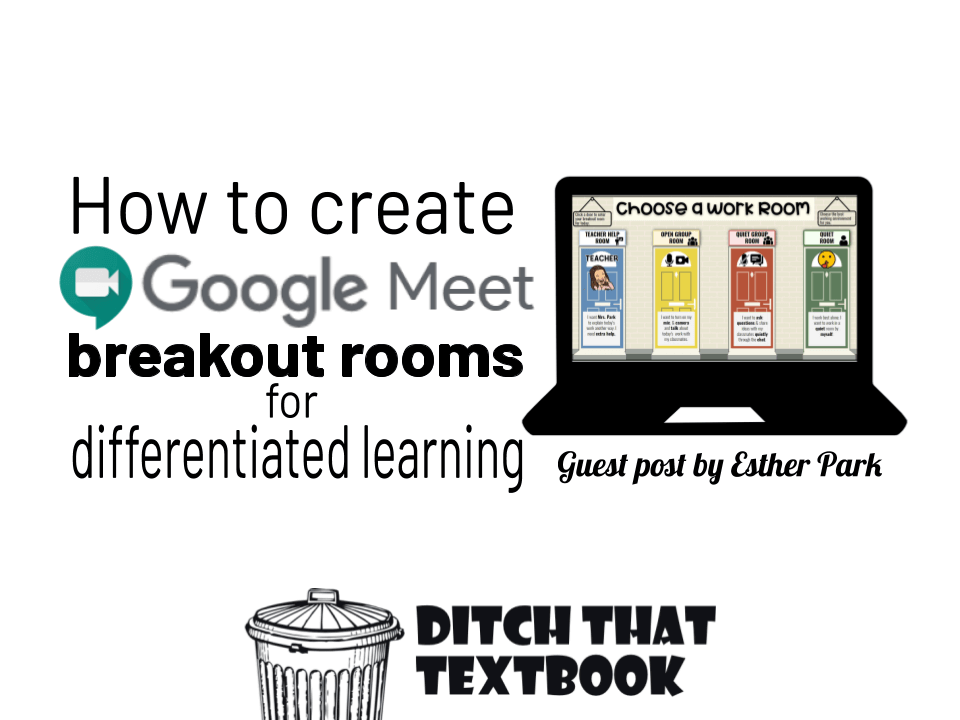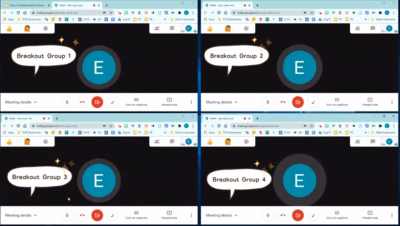
This post is written by Esther Park. Esther is a high school English as a New Language teacher in Northern Virginia. You can connect with her on Twitter @MrsParkShine or on her website: mrspark.org
Using breakout rooms completely changed the way I teach remotely. But one day, one of my quiet students privately messaged me during a video call and politely asked if she can work independently. “I work much better alone in a quiet place,” she said. After her request, I decided to ditch the “one size fits all” approach to using breakout rooms.
I created this Google Slide to give students a choice and agency to their virtual workspace. As you can see, students are given 4 breakout room options based on their learning styles and preferences.
Breakout Room 1: Teacher Help Room
Students can either stay in the main meeting room or move to a new breakout room where you can offer extra assistance. Once their questions are clarified, students can move to another breakout room or stay in the room.
Breakout Room 2: Open Group Room
This is a room for the extroverts. We want to honor their learning styles and offer a virtual space that channels their energy and longing for social connections. After going over clear expectations and digital citizenship, allow this group to turn on the camera and microphones to collaborate.
Breakout Room 3: Quiet Group Room
This is a room where students will collaborate quietly through the chat, ask questions, and share ideas.
Breakout Room 4: Quiet Room
If I were a student, I would be the one power-working in this room. This is a virtual space where students can have uninterrupted, focused time in peace and quiet.
Here are 7 practical steps to set up and manage choice breakout rooms.
Step 1: Create video call links.
My district uses Google Meet, and there are 2 ways you can create new Meet links. (1) Schedule new meetings through meet.google.com. (2) Create multiple Google Classrooms and use Meet links generated through Classroom.
Step 2: Hyperlink.
Create your own or use my choice room template and link each door to different Google Meet links.
Step 3: Share the slide with students.
If you are using Google Slides, I suggest changing the last part of the link URL to “PREVIEW” or “PRESENT”. This way, your students see the slide in a new tab in presentation mode. Students will click one door to enter the breakout room.
Step 4: Keep all breakout rooms open to be virtually present.
One of the advantages of using Google Meet is that teachers can be in all video calls simultaneously. Students can virtually see you in the breakout rooms, and you are able to intervene seamlessly as needed. Suggestion: Use “ Tab Resize” Chrome extension to split the screen and organize your tabs.

Step 5: Mute and unmute your microphone.
Since you are in all 4 meetings, don’t forget to mute your microphone. For example, students in your “Quiet Room” will not want to hear you helping your students in the “Teacher Help Room”. Also, if you would like to make a whole class broadcast, simply, unmute all microphones and make the announcement.
Step 6: Mute and unmute audio coming from different tabs.
Again, since you are in all 4 meetings, you will have audio coming out from multiple tabs. I use a Chrome extension called “Mute Tab” to mute certain tabs. This way, your ears will be at peace.
Step 7: Decide on a teacher attention-getter signal.
Although your students can see you in their breakout rooms, you will not be able to provide immediate attention since your tab may be muted or you might be busy helping students in another breakout room. As a class, decide on a signal. It can be as simple as a “I need help” message in the chat box, a big hand wave at the camera, or a group dab!
Watch my tutorial to learn how to use Chrome extensions and monitor multiple Google Meet rooms.
Creating Zoom Breakout Rooms for Differentiated Learning
Using Zoom? No problem!
Teachers on Twitter have been adapting this strategy and making it work on Zoom. You can send out a quick poll asking about their workroom preferences and assign breakout rooms based on their responses. Also, check out this idea from Angelina Murphy! You can make a copy of her Zoom Breakout Room Working Style Selection template here.
I tried a new strategy today that went AMAZING! Inspired by a post by @MrsParkShine, I had students pick their own working style and placed them in breakout rooms accordingly: an open room to talk, quiet room to type in the chat, a teacher support room, and an independent room. pic.twitter.com/gwRWyyak6D
— Angelina Murphy (@magicalmsmurphy) September 23, 2020
More Google Slides templates!
If you are looking for more ways to use Google slides and promote student choice and collaboration, check out my website. I have been adding free templates and resources to help you navigate through remote learning.
For notifications of new Ditch That Textbook content and helpful links:
Are you looking for quality, meaningful professional learning that both equips and inspires teachers?
Matt provides in-person and virtual keynotes, workshops and breakout sessions that equip, inspire and encourage teachers to create change in their classrooms. Teachers leave with loads of resources. They participate. They laugh. They see tech use and teaching in a new light. Click the link below to contact us and learn how you can bring Matt to your school or district!
Is Matt presenting near you soon? Check out his upcoming live events!





Thank you so much! Your template and tutorial are exactly what I was looking for in a breakout template!
Are you using the actual Breakout Rooms feature on google meets, or setting up four separate meetings?
It looks like they’re using four separate meetings. If I remember correctly, Google Meet didn’t have breakout rooms until October 2020
This seems like a great idea. Couple of questions – First, what’s the purpose of having a separate room for quiet work? Couldn’t those students just stay in one of the other rooms and mute themselves? And second, you mentioned students staying in the “main room” — so is there a fifth room here that encompasses all the others? (If so, couldn’t that room turn into the “teacher room” when it’s time?)
We did this today but the chrome mute tab extension didn’t work for me. I had the extension, it had access, I could see the “m” when I attempted to mute however I could still hear them. Any suggestions? Thank you!
We have tried using this method, but the performance really lags on teacher Mac’s and Chromebooks when four video streams are open at the same time. One of our solutions is to open the four, but leave three of the meets, leaving the tabs open. As long as someone is still in the Meet it won’t close even if you’ve disabled student ability to create Meets.
When you want to leave a room, leave the Meet and enter another. This limits the streams coming in. It takes a few more seconds to move in and out, but your computer will thank you.
If your school has GSuite, you can also create standing meet links within your district using the magic and poorly documented lookup URLs. Either the long form meet.google.com/lookup/YOUR-CODE-HERE or the short form g.co/meet/YOUR-CODE-HERE. Codes need to be unique within your school because anyone in your school who goes to the same code at the same time will end up in a meeting together.
Ah! This is solid advice Tom! That does make it easier. Thanks for sharing this.
[…] Read the full story by Ditch That Textbook […]